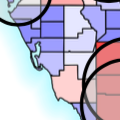Abstract
Zika virus (ZIKV) is causing an unprecedented epidemic linked to severe congenital syndromes. In July 2016, mosquito-borne ZIKV transmission was first reported in the continental United States and since then, hundreds of locally-acquired infections have been reported in Florida. To gain insights into the timing, source, and likely route(s) of introduction of ZIKV into the continental United States, we tracked the virus from its first detection in Miami, Florida by direct sequencing of ZIKV genomes from infected patients and Aedes aegypti mosquitoes. We show that at least four distinct ZIKV introductions contributed to the outbreak in Florida and that local transmission likely started in the spring of 2016 - several months before its initial detection. By analyzing surveillance and genetic data, we discovered that ZIKV moved among transmission zones in Miami. Our analyses show that most introductions are phylogenetically linked to the Caribbean, a finding corroborated by the high incidence rates and traffic volumes from the region into the Miami area. By comparing mosquito abundance and travel flows, we describe the areas of southern Florida that are especially vulnerable to ZIKV introductions. Our study provides a deeper understanding of how ZIKV initiates and sustains transmission in new regions.
